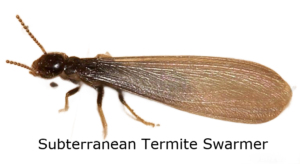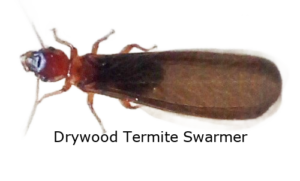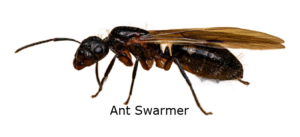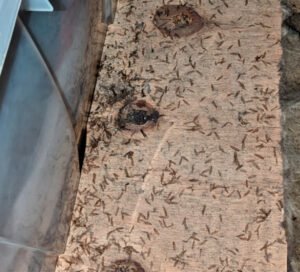Termite Swarming: What You Should Know
San Diego is home to two primary types of termites: drywood and subterranean termites, both of which spread through swarming. Here’s a breakdown of their behavior and what it means for you:
 Subterranean Termites
Subterranean Termites
- Swarming Season: Spring
- Swarming Behavior: On warm, wet days, 50–100 flying termites leave their colony, often from exit tubes, to establish new ones. After landing, they find a mate, burrow into damp soil, and begin reproducing. Not long after, their offspring will start foraging for food.
 Drywood Termites
Drywood Termites
- Swarming Season: Fall
- Swarming Behavior: These termites also swarm on warm, humid days. Once paired, they seek out a crack in wood to establish their colony.
Identifying Termite Swarmers
- Size: About ¼ to ½ inch in length
- Appearance:
- Both types have broad, dark-colored bodies and two pairs of equal-length wings.
- Drywood termites: Red heads
- Subterranean termites: Dark heads
- Ant vs. Termite Swarmers:
 Ants have pinched waists and elbowed antennae. They also have two pairs of wings but of not equal length.
Ants have pinched waists and elbowed antennae. They also have two pairs of wings but of not equal length. - Termites have broad waists and straight antennae. Their wings are the same length.
Survival Rates and Impact
- 97% of termite swarmers don’t survive.
- However, the 3% that do create significant damage, fueling a multi-billion-dollar industry.
What to Do During a Swarm
- Outside Your Home: Swarms outside are less concerning, especially if you have a full-structure termite warranty with annual inspections.
- Inside Your Home or Business:
Swarms indoors are a bigger issue. Dozens of flying termites may appear suddenly, often heading toward light sources. While it might seem like they’re coming from a window or door frame, the source is often hidden and difficult to locate.
Swarming termites provide a critical opportunity to identify their point of origin—the area that requires treatment. Many people mistakenly focus on the termites on the ground instead of locating where they are coming from, which is key to addressing the problem effectively.
 Wings: Termite swarmers have perforated wings that are discarded after landing. Finding a pile of these wings in your home indicates a recent swarm, signaling that termites are actively seeking mates and a location to establish a new colony.
Wings: Termite swarmers have perforated wings that are discarded after landing. Finding a pile of these wings in your home indicates a recent swarm, signaling that termites are actively seeking mates and a location to establish a new colony.
Real-Life Swarming Incidents
- Ocean Beach: A busy bar faced a swarm near its popular ocean-view tables.
- La Jolla: An upscale spa had a swarm during client treatments.
- Encinitas: A salon experienced a swarm on a bustling Saturday.
- Residential: An elderly widow was woken up by swarming termites in her bedroom.
In only one case (the bar), was it possible to pinpoint and access the originating colony. The others required full tenting because the origination point was inaccessible.
Prevention and Management
- Regular Inspections: Schedule routine inspections to detect termite activity early.
- Borate Treatments: Treat exposed wood in attics, garages, or crawlspaces. Borate kills termites if they chew the wood.
- Don’t Ignore Signs:
- Covering termite kick-out holes with tape doesn’t kill the colony—it only redirects them to another exit.
- Left unchecked, colonies can develop reproductive members (alates), which swarm to start new colonies. Colonies may splinter into multiple colonies supported by secondary reproductives.
Key Takeaways
- Proactive inspections, timely interventions, and preventative measures like borate treatments are essential.
- Ignoring termite activity worsens the problem—termites will not disappear on their own.
- If you suspect termite activity, act immediately. Waiting will only make the issue more costly and challenging to resolve.
John Gelhard
Owner/Operator of California Termite, Operator License No. 14720.
